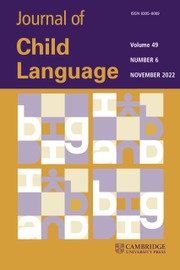Article contents
A metrical template account of children's weak syllable omissions from multisyllabic words*
Published online by Cambridge University Press: 26 September 2008
Abstract
Young children learning English as well as many other languages frequently omit weakly stressed syllables from multisyllabic words. In particular, they are more likely to omit weak syllables from word-initial positions than from word-internal or -final positions. For example, the weak syllable of a weak-strong (WS) word like giraffe is much more likely to be omitted than the weak syllable of a SW word like tiger. Three hypotheses for this omission pattern have been offered. In two, children's weak syllable omissions reflect innate perceptual biases either to ignore initial weak syllables or to encode word-final syllables. In contrast, the SW Production Template Hypothesis states that children have a template for producing a strong syllable followed by an optional weak syllable. When they apply a series of SW templates to their intended utterances, weak syllables that do not fit the templates are more likely to be omitted than those that do. To compare the three hypotheses, young two-year-olds were asked to say four-syllable SWWS and WSWS nonsense words. Children's pattern of weak syllable preservations was highly consistent with the SW production template hypothesis, but not with the perception-based hypotheses. Implications of this research for children's function morpheme omissions and for the relation of metrical and segmental production templates are discussed.
Information
- Type
- Articles
- Information
- Copyright
- Copyright © Cambridge University Press 1994
Footnotes
Thanks to Tom Bever, Peter Jusczyk, Elissa Newport and Alice Turk who provided helpful feedback on earlier versions of the paper. Thanks to Karen Angyal, Mary Boyle, Kimberly Clor, Michele Glaser, Dayana Jimenez, Deborah Rott and Michele Shady for data collection. Thanks also to the parents and children who participated in the research. Research and manuscript preparation were supported by SUNY at Buffalo Research Development Funds and NSF grant No. BNS9120952.
References
REFERENCES
- 117
- Cited by

